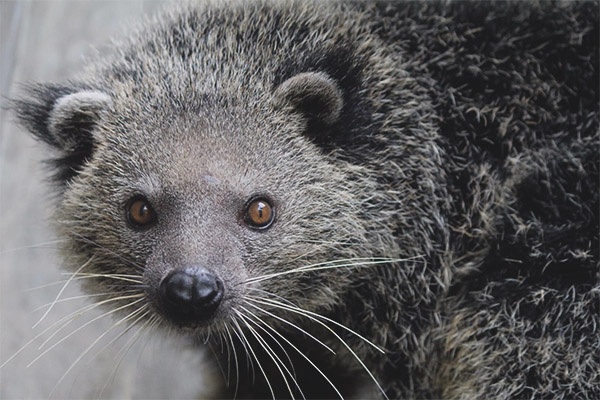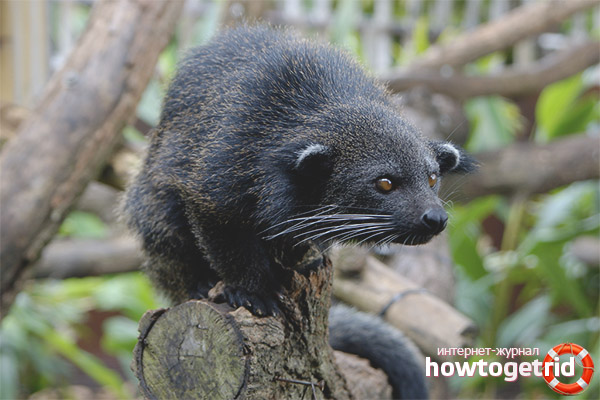The content of the article
Wildlife, with all its beautiful, unique landscapes and incredible creatures, is full of wonders and intrigues. Sometimes you can see an unusual animal or plant, striking in its beauty, or vice versa - frightening. When the word predator immediately appears a terrible big animal with sharp fangs. But some predators cause only emotion and desire to stroke. These predators include little-known binturong.
Looking at him, it may occur to him that his face is like that of a cat, and his body is like that of a bear, with long shaggy black hair, a stiff gray mustache and a long tail. It is a carnivore with a tenacious tail; which is adapted to capture various things. Binturong smells like a fresh batch of popcorn. It is also sometimes called "bear cat", but this name is misleading, since these animals are not associated with bears or cats.
Binturong belongs to the family of civets, an ancient group of small and medium-sized mammals that live only in the Old World (eastern hemisphere). This family, which also contains civets, genetts, is one of the most diverse of all carnivorous families, covering 66 species distributed throughout Europe, Africa and India. There are 9 different types of binturong, which are slightly different in appearance, but they are easiest to distinguish by geography and size.
Description
Binturong is unique compared to other predatory mammals,because it has an atrial tip to its tail, which serves the animal as another leg that helps with climbing and grabbing the branches to give the animal stability. The animals have large bulging eyes, white, thick and long whiskers, which are too sensitive, and are located on the cheeks, stick up above the brown eyes.
Where dwell
Binturong is found in South and Southeast Asia. Its wide range of distribution extends from Java Island in Indonesia to Yunnan in South China. The countries in which binturong resides include: Nepal, Bangladesh, India, China, Indonesia, Bhutan. Although in some countries they are still present, their numbers are rapidly decreasing, and they are now very difficult to detect there. They live in the humid, dense tropical jungle and high forests that are close to water.
Character, lifestyle
Binturong is basically a nocturnal animal that spends most of its time, slowly moving between the trees. Since the animals are quite large, they cannot jump between trees, so they must first descend to move to the next tree.
These animals are excellent climbers and move well in the trees, leaning on their strong legs, half-sliding claws, and also a rather tenacious tail. Binturong also knows how to swim and dive perfectly. He is often in a pond, so that his body cools down in extreme heat. They usually live alone, but small groups of representatives of the species are not uncommon, and usually consist of two adult animals, as well as their young.
The beast is known as a sufficiently vocal animal that makes a series of sounds, with the help of which it communicates with the rest of the bionturongs and warns them if it sees danger. They are able to reproduce the sounds of giggles when they look happy, or howl when they feel danger.
Like the rest of the civet family, binturong has odorous glands that are under the tail. These glands are used to label trees and foliage when marking individual territories, and are used while the beast is moving. Oddly enough, the smell of this secret, as they say, smells of popcorn.
Until they become stronger and more aware of their surroundings, young binturongs are incredibly vulnerable.At this time, they are capable of spraying liquid with an unpleasant odor (like a skunk) when they were really scared. This behavior was observed only in binturongs, who are not more than two months old, because when they get older, they can protect themselves in another way.
Binturong can turn the hind legs backwards so that their claws will mate well when descending a tree trunk.
Nutrition
Despite the fact that they belong to the group of predatory mammals, binturong is a herbivorous animal. This means that it survives primarily on a diet consisting of fruits. But their diet also includes insects, various rodents and small birds, which they trap among the branches like cats.
Binturongs are well developed, and can eat food while sitting in the trees with the help of the front paws, which these animals need not only for lifting and digging, but also for keeping food or opening fruits with their flexible fingers. Binturong mainly hunts for prey under cover of night. During the day, due to its ability to swim and dive perfectly, it fishes in water bodies when cooled in the heat.
Reproduction and life cycles
They do not have the mating season as such; it is believed that between February and mid-spring, and then in July and October, they are more prone to breeding. After a gestation of 3 months, the female binturong descends from the trees to nest among the vegetation that protects her from passing predators.
As a rule, 1-3 babies are born. Just like many other mammals, small binturongs are born blind and cannot hear. They rely solely on their mother, who provides them with milk. Independent life begins to 2 months. Grow up to 1 year.
Binturongs in nature can live from 10 to 15 years, but are able to successfully reach older age when kept in captivity, and die at 26 years of age.
Danger
Binturongs are relatively large and slow animals, but they are not easy prey for predators living in the jungle. Larger inhabitants, such as tigers and snakes, pose a threat to binturongs.
Representatives of this species suffered the most from habitat destruction.For the most part, this is manifested in the southern parts of the range. In the northern zone, deforestation is not so intense, but there they suffer from poachers, so this animal likes a dense forest, where there are many shelters, both in trees and on the surface of the earth.
Benefits and relationships with people
Binturong is also subject to the devastating loss of vast areas of its natural habitat. The growing population and forest clearing for agriculture are the main culprits of their decline, as binturong needs dense jungle for successful survival.
Binturong brings great benefits to the forests and jungles where they inhabit. Thanks to their faeces, they help spread the seeds from the fruits and vegetables that they feed on.They also help in the fight against pests, as they catch and eat rodents.
Binturong animal is considered rare and exotic, so it is almost impossible to meet in zoos of many countries.
Video: Binturong (Arctictis binturong)













To send